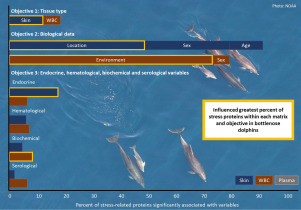当前位置:
X-MOL 学术
›
Comp. Biochem. Physiol. D Genom. Proteom.
›
论文详情
Our official English website, www.x-mol.net, welcomes your
feedback! (Note: you will need to create a separate account there.)
Environment, endocrinology, and biochemistry influence expression of stress proteins in bottlenose dolphins.
Comparative Biochemistry and Physiology D: Genomics & Proteomics ( IF 2.2 ) Pub Date : 2019-07-26 , DOI: 10.1016/j.cbd.2019.100613 Abbey E Wilson 1 , Patricia A Fair 2 , Ruth I Carlson 1 , Magali Houde 3 , Marc Cattet 4 , Gregory D Bossart 5 , Dorian S Houser 6 , David M Janz 1
Comparative Biochemistry and Physiology D: Genomics & Proteomics ( IF 2.2 ) Pub Date : 2019-07-26 , DOI: 10.1016/j.cbd.2019.100613 Abbey E Wilson 1 , Patricia A Fair 2 , Ruth I Carlson 1 , Magali Houde 3 , Marc Cattet 4 , Gregory D Bossart 5 , Dorian S Houser 6 , David M Janz 1
Affiliation

|
Natural and anthropogenic stressors have been reported to impact the health of marine mammals. Therefore, investigation of quantifiable biomarkers in response to stressors is required. We hypothesized that stress protein expression would be associated with biological and health variables in wild and managed-care bottlenose dolphins (Tursiops truncatus). To test this hypothesis, our study objectives were to (1) determine if stress proteins in skin, white blood cells (WBCs), and plasma could be measured with an antibody-based microarray, (2) measure stress-protein expression relative to biological data (location, sex, age, environment), and (3) determine if stress-protein expression was associated with endocrine, hematological, biochemical and serological variables and gene expression in bottlenose dolphins. Samples were collected from two wild groups (n = 28) and two managed-care groups (n = 17). Proteins involved in the HPA axis, apoptosis, proteotoxicity, and inflammation were identified as stress proteins. The expression of 3 out of 33 proteins was significantly (P < 0.05) greater in skin than plasma and WBCs. Male dolphins had significantly greater expression levels for 10 proteins in skin compared to females. The greatest number of stress-associated proteins varied by the dolphins' environment; nine were greater in managed-care dolphins and 15 were greater in wild dolphins, which may be related to wild dolphin disease status. Protein expression in skin and WBCs showed many positive relationships with measures of plasma endocrinology and biochemistry. This study provides further understanding of the underlying mechanisms of the stress response in bottlenose dolphins and application of a combination of novel methods to measure stress in wildlife.
中文翻译:

环境,内分泌学和生物化学影响宽吻海豚中应激蛋白的表达。
据报道,自然和人为的压力源会影响海洋哺乳动物的健康。因此,需要对可量化的生物标记物响应应激源进行研究。我们假设应激蛋白的表达将与野生和管理型宽吻海豚(Tursiops truncatus)的生物学和健康变量相关。为了验证这一假设,我们的研究目标是(1)确定是否可以使用基于抗体的微阵列测量皮肤,白细胞(WBC)和血浆中的应激蛋白,(2)相对于生物测定应激蛋白的表达数据(位置,性别,年龄,环境),以及(3)确定应激蛋白表达是否与宽吻海豚的内分泌,血液学,生化和血清学变量以及基因表达相关。从两个野生组(n = 28)和两个管理治疗组(n = 17)收集样本。与HPA轴,细胞凋亡,蛋白毒性和炎症有关的蛋白被鉴定为应激蛋白。33种蛋白质中有3种在皮肤中的表达明显高于血浆和WBCs(P <0.05)。与雌性相比,雄性海豚在皮肤中10种蛋白质的表达水平明显更高。应激相关蛋白的最大数量因海豚的环境而异。管理型海豚中有9例更大,而野生海豚中有15例更大,这可能与野生海豚的病情有关。皮肤和白细胞中的蛋白质表达与血浆内分泌和生化指标之间存在许多正相关关系。
更新日期:2019-07-26
中文翻译:

环境,内分泌学和生物化学影响宽吻海豚中应激蛋白的表达。
据报道,自然和人为的压力源会影响海洋哺乳动物的健康。因此,需要对可量化的生物标记物响应应激源进行研究。我们假设应激蛋白的表达将与野生和管理型宽吻海豚(Tursiops truncatus)的生物学和健康变量相关。为了验证这一假设,我们的研究目标是(1)确定是否可以使用基于抗体的微阵列测量皮肤,白细胞(WBC)和血浆中的应激蛋白,(2)相对于生物测定应激蛋白的表达数据(位置,性别,年龄,环境),以及(3)确定应激蛋白表达是否与宽吻海豚的内分泌,血液学,生化和血清学变量以及基因表达相关。从两个野生组(n = 28)和两个管理治疗组(n = 17)收集样本。与HPA轴,细胞凋亡,蛋白毒性和炎症有关的蛋白被鉴定为应激蛋白。33种蛋白质中有3种在皮肤中的表达明显高于血浆和WBCs(P <0.05)。与雌性相比,雄性海豚在皮肤中10种蛋白质的表达水平明显更高。应激相关蛋白的最大数量因海豚的环境而异。管理型海豚中有9例更大,而野生海豚中有15例更大,这可能与野生海豚的病情有关。皮肤和白细胞中的蛋白质表达与血浆内分泌和生化指标之间存在许多正相关关系。











































 京公网安备 11010802027423号
京公网安备 11010802027423号